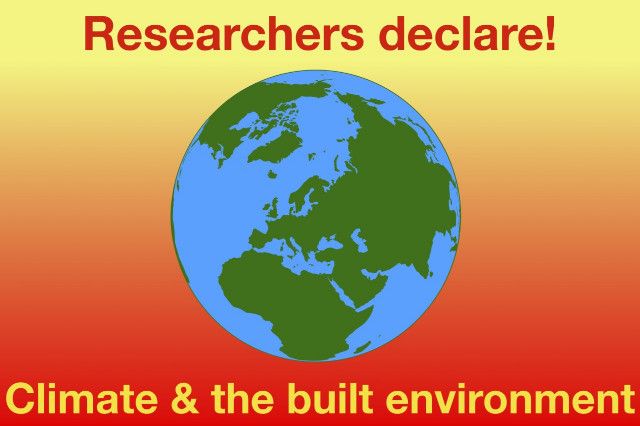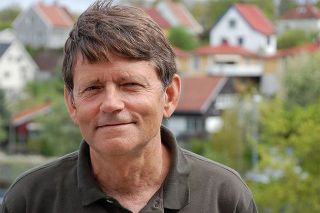
www.buildingsandcities.org/insights/news/graz-declaration-built-environment.html
Graz Declaration for Climate Protection in the Built Environment: A Call for Carbon Neutrality

A series of coordinated principles and actions were recently created by the research community for policy makers, researchers and practitioners, through the Graz Declaration.
The Graz Declaration calls for the delivery of a carbon neutral built environment, embracing the need for clear scaleable targets and budgets that include embodied and operational GHG emissions. The Graz Declaration for Climate Protection in the Built Environment was developed, discussed and adopted by participants from 31 countries during the international conference on Sustainable Built Environment (SBE19 Graz) which took place in Graz, Austria from 10 to 14 September 2019.
With the goal of the most precise and action-oriented demands on politics, economy and society as well as the willingness to enter into self-commitments, participants of SBE19 Graz[1] developed a declaration in several workshops. It responds to the need for great urgency to act now on mitigation measures especially in the areas of constructed assets, the construction and real estate industry as well as urban development.
The Graz Declaration calls for determined action to rapidly reduce GHG emissions as a contribution to climate protection and sustainable development. In particular, it reminds policy-makers of their role in formulating binding requirements for environmental protection. A key goal is to introduce GHG budgets (comparable to a cost framework) that would be compatible with the Intergovernmental Panel on Climate Change's GHG-emission reduction targets. These targets and budgets need to be scalable (for construction products, buildings and sites, cities and building portfolios) and have clearly defined timeframes in order to deliver net-zero GHG-emission levels by or before the middle of this century. To be effective, targets and budgets must be enshrined in legislation and standards. Requirements need to be framed in terms of performance and 'technology open' approaches[2] to allow and stimulate a fair competition for the best solutions.
The Graz declaration addresses the significant contribution that the construction and real estate sectors have on resource use and global environmental impacts. The creation and operation of constructed works is the source of almost 40% of climate change-causing emissions.[3]
Buildings and infrastructure form the basis for social and economic development, but the quality of the built environment has a big impact on humans i.e. life and work. They are physical man-made objects with long service lives and modernization cycles. Buildings created over the coming years will be almost unchanged by 2050. Equal consideration must also be given to existing building stocks.
Translation of science based global targets into actions for the specific sectors and actors is the overall objective of the Graz Declaration. These are five out of the 13 points that make this declaration particularly significant:
- The need to set clear carbon budgets as design targets that are scaleable for the environment:
The mandatory introduction of national design targets for limiting the carbon footprint of buildings over their life cycle is required by 2025 at the latest. This period covers, on the one hand, the development and implementation of initiatives in standardization and legislation, as well as the provision of the necessary data and tools. In many countries, the results of research can be used. At the same time, 2025 is the time when new construction and modernisation projects must be geared to the IPCC 2050 targets - they will not be adjusted again.
- The recognition that both embodied AND operational GHG emissions in the life cycle of construction works must be accounted for:
The previous focus in the discussion on the use phase only leads to misjudgments and burden shifting. It is therefore necessary to take into account resource use and environmental impacts arising from the production and replacement of construction products in a cross-sectoral approach. This leads to the demand for the assessment and targeted based optimisation of the carbon footprint in the life cycle of buildings.
- The role of the research community in the provision of clear, independent and robust information, metrics and tools:
The importance of science-based targets, which are based on the planetary boundaries and serve the top-down derivation of political goals, is increasing. The research community is called upon to actively advise and support politics, industry and society, as well as to provide the necessary methods and tools for application.
- Higher education and training must change the curriculum before 2025 to ensure that decarbonization and the SDGs are central components:
This includes the teaching of fundamental principles, systems-thinking orientation, practice-oriented skills and solutions for net-zero GHG-emission built environment.
- The built environment professions and vocations must provide mandatory training to their members:
An essential responsibility for governments
and relevant institutions is to ensure the workforce has the knowledge and
skills to create, operate and maintain a net-zero GHG-emission built
environment.
The Graz Declaration promotes and fosters current developments in the EU to improve climate protection in the construction sector. Legislative initiatives are being launched in several countries, sustainability benchmarks are being reformulated with more stringent benchmarks and national standardization organizations are taking up the issue.
The initiators suggest that progress be reported at the World Conference WSBE2020 in Gothenburg and that the topic then be taken up again in an international context.
The Graz Declaration is available at: https://www.tugraz.at/en/events/sbe19/graz-declaration/graz-declaration/
Colleagues from science, construction and civil society are invited to sign the Graz Declaration and so actively support the transitions towards achieving climate protection goals in the construction sector through their active actions.
Report by Alexander
Passer1, Thomas Lützkendorf2, Guillaume Habert3,
Helga Kromp-Kolb4, Michael Monsberger5, Michael Eder1
1 Graz University of Technology, Institute of Technology and Testing of Building Materials Working Group Sustainable Construction
2 Karlsruhe Institute of Technology, Centre for Real Estate
3 ETH Zürich, Institute of Construction & Infrastructure Management, Chair of Sustainable Construction
4 University of Natural Resources and Life Sciences, Vienna, Institute of Meteorology Centre for Global Change and Sustainability
5 Graz University of Technology, Institute of Construction Management and Economics
Footnotes
[1] The conference was co-organised by four institutions from Austria, Germany and Switzerland: Graz University of Technology; University of Natural Resources and Life Sciences, Vienna; Karlsruhe Institute of Technology and ETH Zurich.
[2] Technology open approaches are those chosen on their technical merit and that allow an open process for anyone to participate freely.
[3] https://globalabc.org/uploads/media/default/0001/01/3e7d4e8830bfce23d44b7b69350b2f8719cd77de.pdf
Latest Peer-Reviewed Journal Content
A framework for 1.5°C-aligned GHG budgets in architecture
G Betti, I Spaar, D Bachmann, A Jerosch-Herold, E Kühner, R Yang, K Avhad & S Sinning
Net zero retrofit of the building stock [editorial]
D Godoy-Shimizu & P Steadman
Co-learning in living labs: nurturing civic agency and resilience
A Belfield
The importance of multi-roles and code-switching in living labs
H Noller & A Tarik
Researchers’ shifting roles in living labs for knowledge co-production
C-C Dobre & G Faldi
Increasing civic resilience in urban living labs: city authorities’ roles
E Alatalo, M Laine & M Kyrönviita
Co-curation as civic practice in community engagement
Z Li, M Sunikka-Blank, R Purohit & F Samuel
Preserving buildings: emission reductions from circular economy strategies in Austria
N Alaux, V Kulmer, J Vogel & A Passer
Urban living labs: relationality between institutions and local circularity
P Palo, M Adelfio, J Lundin & E Brandão
Living labs: epistemic modelling, temporariness and land value
J Clossick, T Khonsari & U Steven
Co-creating interventions to prevent mosquito-borne disease transmission in hospitals
O Sloan Wood, E Lupenza, D M Agnello, J B Knudsen, M Msellem, K L Schiøler & F Saleh
Circularity at the neighbourhood scale: co-creative living lab lessons
J Honsa, A Versele, T Van de Kerckhove & C Piccardo
Positive energy districts and energy communities: how living labs create value
E Malakhatka, O Shafqat, A Sandoff & L Thuvander
Built environment governance and professionalism: the end of laissez-faire (again)
S Foxell
Co-creating justice in housing energy transitions through energy living labs
D Ricci, C Leiwakabessy, S van Wieringen, P de Koning & T Konstantinou
HVAC characterisation of existing Canadian buildings for decarbonisation retrofit identification
J Adebisi & J J McArthur
Simulation and the building performance gap [editorial]
M Donn
Developing criteria for effective building-sector commitments in nationally determined contributions
P Graham, K McFarlane & M Taheri
Reimagining circularity: actions for optimising the use of existing buildings
R Lundgren, R Kyrö, S Toivonen & L Tähtinen
Effective interdisciplinary stakeholder engagement in net zero building design
S Vakeva-Baird, F Tahmasebi, JJ Williams & D Mumovic
Metrics for building component disassembly potential: a practical framework
H Järvelä, A Lehto, T Pirilä & M Kuittinen
The unfitness of dwellings: why spatial and conceptual boundaries matter
E Nisonen, D Milián Bernal & S Pelsmakers
Environmental variables and air quality: implications for planning and public health
H Itzhak-Ben-Shalom, T Saroglou, V Multanen, A Vanunu, A Karnieli, D Katoshevski, N Davidovitch & I A Meir
Exploring diverse drivers behind hybrid heating solutions
S Kilpeläinen, S Pelsmakers, R Castaño-Rosa & M-S Miettinen
Urban rooms and the expanded ecology of urban living labs
E Akbil & C Butterworth
Living with extreme heat: perceptions and experiences
L King & C Demski
A systemic decision-making model for energy retrofits
C Schünemann, M Dshemuchadse & S Scherbaum
Modelling site-specific outdoor temperature for buildings in urban environments
K Cebrat, J Narożny, M Baborska-Narożny & M Smektała
Understanding shading through home-use experience, measurement and modelling
M Baborska-Narożny, K Bandurski, & M Grudzińska
Building performance simulation for sensemaking in architectural pedagogy
M Bohm
Beyond the building: governance challenges in social housing retrofit
H Charles
Heat stress in social housing districts: tree cover–built form interaction
C Lopez-Ordoñez, E Garcia-Nevado, H Coch & M Morganti
An observational analysis of shade-related pedestrian activity
M Levenson, D Pearlmutter & O Aleksandrowicz
Learning to sail a building: a people-first approach to retrofit
B Bordass, R Pender, K Steele & A Graham
Market transformations: gas conversion as a blueprint for net zero retrofit
A Gillich
Resistance against zero-emission neighbourhood infrastructuring: key lessons from Norway
T Berker & R Woods
Megatrends and weak signals shaping future real estate
S Toivonen
A strategic niche management framework to scale deep energy retrofits
T H King & M Jemtrud
Generative AI: reconfiguring supervision and doctoral research
P Boyd & D Harding
Exploring interactions between shading and view using visual difference prediction
S Wasilewski & M Andersen
How urban green infrastructure contributes to carbon neutrality [briefing note]
R Hautamäki, L Kulmala, M Ariluoma & L Järvi
Implementing and operating net zero buildings in South Africa
R Terblanche, C May & J Steward
Quantifying inter-dwelling air exchanges during fan pressurisation tests
D Glew, F Thomas, D Miles-Shenton & J Parker
Western Asian and Northern African residential building stocks: archetype analysis
S Akin, A Eghbali, C Nwagwu & E Hertwich
Join Our Community

The most important part of any journal is our people – readers, authors, reviewers, editorial board members and editors. You are cordially invited to join our community by joining our mailing list. We send out occasional emails about the journal – calls for papers, special issues, events and more.
We will not share your email with third parties. Read more



Latest Commentaries
COP30 Report
Matti Kuittinen (Aalto University) reflects on his experience of attending the 2025 UN Conference of the Parties in Belém, Brazil. The roadmaps and commitments failed to deliver the objectives of the 2025 Paris Agreement. However, 2 countries - Japan and Senegal - announced they are creating roadmaps to decarbonise their buildings. An international group of government ministers put housing on the agenda - specifying the need for reduced carbon and energy use along with affordability, quality and climate resilience.
Building-Related Research: New Context, New Challenges
Raymond J. Cole (University of British Columbia) reflects on the key challenges raised in the 34 commissioned essays for Buildings & Cities 5th anniversary. Not only are key research issues identified, but the consequences of changing contexts for conducting research and tailoring its influence on society are highlighted as key areas of action.